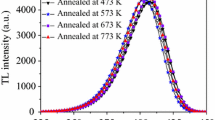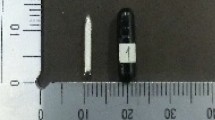Abstract
Sources, components and calibration of paleodose were studied for proper evaluation of the paleodose of porcelain in thermoluminescence (TL) dating. In the TL dating of porcelain using the pre-dose technique, the β dose from the internal natural radiation in the body of porcelain is the first, the environmental dose the second, and the α dose negligible. Sample thickness of 0.2–0.5 mm was used in the paleodose calibration. For a porcelain sample of such thickness, the distribution of β dose inside the sample was nonlinear when the sample (aluminium replaces porcelain in this experiment) was irradiated by a laboratory 90Sr-90Y β source. Therefore, the β dose used was only an average value. A distribution curve of β dose and the calculation of average β dose in the sample were obtained, according to the build-up and attenuation effects of β dose in the sample. The results showed that a sample thickness of 200 μm resulted in an average dose increment of about 4% compared to the surface whereas for a sample with a thickness of 400 μm, the average dose reduced by the same percentage, and that for a sample of 300 μm in thickness the average dose is equal to surface dose approximately. The average β dose in samples with various thickness can be obtained by the provided equations.
Similar content being viewed by others
References
Wang W D, Xia J D, Zhou Z X. Thermoluminescence dating of the ancient Chinese porcelain using a regression method of saturation exponential in pre-dose technique. Sci China Ser E-Tech Sci, 2006, 49(2): 194–209
Zimmerman D W. Thermoluminescent dating using fine grains from pottery. Archaeometry, 1971, 13: 29–52
Fleming S J. Thermoluminescent dating: Refinement of the quartz inclusion method. Archaeometry, 1970, 12: 13–30
Wang W D, Zhou Z X, Xia J D. The conversion factor of α radiation efficiency. Nucl Tech (in Chinese), 1997, 20(8): 450–454
Wang W D, Xia J D. Alpha thermoluminescence dosimetry in dating of pottery. Nucl Sci Tech, 1994, 5(2): 79–86
Aitken M J. Thermoluminescence Dating. London: Academic Press, 1985. 120–122
Wang W D, Leung P L, Xia J D, et al. Distinguishing of artificial irradiation by α dose: A method of discrimination imitations of ancient pottery. Nucl Tech (in Chinese), 2003, 26(1): 48–52
Wintle A G, Aitken M J. Absorbed dose from a beta source as shown by thermoluminescence dosimetry. Int J Appl Radioisotopes, 1977, 28: 625–627
Wintle A G, Aitken M J. Thermoluminescence dating of burnt flint: Application to a Lower Palaeolithic site, Terra Amata. Archaeometry, 1977, 19(2): 111–130
Stoneham D. Porcelain dating. PACT, 1983, 9: 227–239
Wang W D. Ultrathin TLD measurement of alpha dose-rate and comparison with alpha counting. Ancient TL, 1985, 1(1): 2–4
Wang W D. Calculation of average beta dose in porcelain irradiated by a 90Sr-90Y source. Sci Conserv Archaeology (in Chinese), 2005, 17(1): 1–4
Author information
Authors and Affiliations
Corresponding author
Rights and permissions
About this article
Cite this article
Wang, W. Evaluation for the paleodose in thermoluminescence dating of porcelain. Sci. China Ser. E-Technol. Sci. 51, 260–267 (2008). https://doi.org/10.1007/s11431-008-0022-z
Received:
Accepted:
Issue Date:
DOI: https://doi.org/10.1007/s11431-008-0022-z




